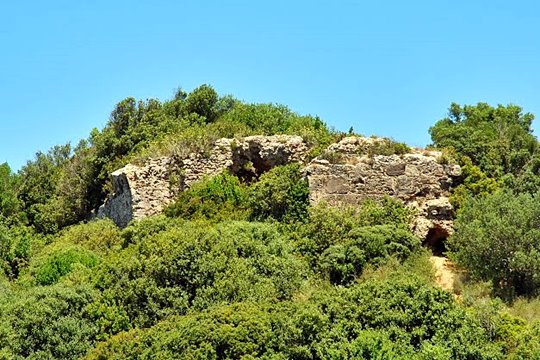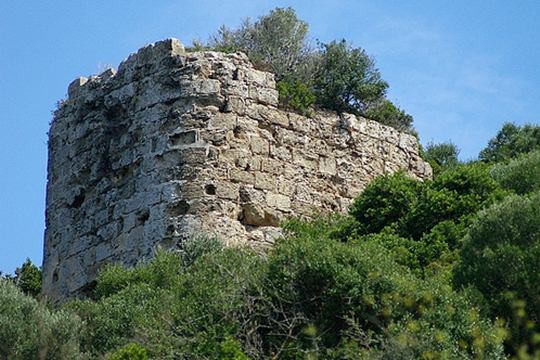History
Find and learn the history of our place.
ANCIENT FEIA
With uninterrupted origin from the Neolithic to the medieval years, Feia or Fea in the current bay of Agios Andreas, in the area of Katakolo, was in ancient times an important port, port of Pisatida and its border with the northern region of Holi Ilida. When Elis subjugated Pisa and the other cities as suburbs, Feia functioned as the second most important after Kyllini port of the Iliad state.
In the Byzantine period the building material of the ancient citadel was used for the construction of a castle, in the lower parts of whose masonry the ancient wall was preserved with obvious traces of its repair by the later (from 1204 onwards) Frankish conquerors. The fortress is known in the sources as Pontikokastro (first mentioned in 1111), a name due to an interpretation of the point, the seaside (mouse, seaside castle) or another version of the similarity of the hill plan with a mouse. In the Chronicle of Morea, the castle was known because in one of its halls the important marriage of Godfrey II Villehardouin, inherited from the Principality of Achaia and Agni Kourtenai, the daughter of the Latin emperor in Constantinople, was arranged to be his friend. her mother as they sailed to the queen. In “Geography Old and New”, the Metropolitan of Athens Meletios gives us the name “Kaloskopion” for the castle of Katakolo, the Greekized version of his Italian name (“Belvedere”).
Feia during the Homeric era was a walled city. Under its walls, according to Homer, took place the conflict of Pylia under Nestor with the Arcadians. In the Odyssey, Telemachus meets Feia on his return journey to Ithaca, having left behind Pylos where he had met Nestor in search of information about his father. It seems that Feia was an important identifier for navigation in the Ionian Sea and trips to the Greek cities of Lower Italy.
During the years of the Peloponnesian War, the port and the city of Feia were also the scene of clashes between the opposing factions, while at the end, it experienced the same fate as Kyllini, losing its walls as a humiliating condition imposed by the victors of the war. Lacedaemonians in the defeated Ilias.
The distance between Feia and Olympia is determined by the geographer Strabo at 120 steps. The traveler Pausanias, however, does not refer to Feia, except to describe a war scene in the shrine of Kypselos which he saw in the sanctuary of Olympia on the subject of the conflict of Pylia; Αρκάδων. Perhaps Feia’s silence in Pausanias’ work shows that in his time the city and the port had declined.
The city of Feia was extensive and sparsely populated, as evidenced by the surviving archaeological remains. In classical times, the komi occupied the entire surface of the cape that is now called Ichthys, approaching to the north the current settlement of Skafidia, where the small river with the ancient name Yardanos flows into the Ionian.
At the top of the hill, above the port, was the citadel of Feia. The view of the surrounding area from this point is excellent, since there is unobstructed visibility to every point of the horizon, to the Ionian, the western Peloponnese up to the mountains of Arcadia.
Throughout antiquity, the port of Feia functioned as an important gateway, especially during the summer months, through which people and goods flowed in a normal flow to and from the state of Ilia. However, this picture changed every four years, in the summer of the Olympic year, as the season of the Games approached. The port and town of Feia, as well as Kyllini further north, welcomed the crowds of Greeks who came in large numbers to the sacred land of Ilia by ships of the time and from mainland Greece and the numerous colonies throughout the Mediterranean, in order to take part in the great religious festival in honor of Zeus in the included sanctuary of Olympia.
Certainly, the hundreds at first and later thousands of pilgrims, brought with them the precious, small or large offerings to the Sanctuary and with them a variety of other goods, animals, goods and items for consumption. The size of the passenger and commercial volume that traveled through the sea routes was progressively increasing, following the evolution and progress of the art of shipbuilding and navigation and the correspondingly growing fame and glory of the Olympic Games. For as long as they lasted, ships of all sizes and types remained anchored in the natural bay of Feia and the port of Kyllini, waiting to be transported at the end of all passengers back to their homeland and with them various agricultural and handicraft products of Ilia . Definitely, the most valuable “cargo” of some ships was the Kotinos and the most important passenger, its Olympic holder, whether it was Milonas from Croton, Diagoras from Rhodes, Theagenis from Thassos and so many others.
The scholar R. Traquair presumes the destruction of Pontikokastro in 1470 by Constantine Paleologos as he acted in the castle of Glarentza as the last before the Turkish owner so that, as the latter came to the Peloponnese, they did not benefit from the conquest.
Among the surviving ruins of the medieval fortress, the tower stands out in the northwest corner, which is maintained at a height of 12 and a width of 8 meters. Also, in the center of the flat surface of the once walled castle are preserved the ruins of a bilateral, vaulted tank 5m long.
Today, the coast and the bottom of the bay of Ag. Andreou, shows huge cracks that show the significant geological changes and transformations that occurred during the centuries of intense seismic activity in the area. In particular, the earthquake of the 6th AD. century which shook the whole northwestern Peloponnese and knocked down the majestic temple of Zeus of Olympia is probably the culprit for the sinking of Feia and its port facilities.
In the late 1950s, archaeologist Nick. Gialouris carried out underwater and coastal research in the gulf of Feia, which yielded rich and varied archaeological findings. According to her, the building remains are located throughout the bay, up to 200m. from the coast and at a depth of up to 5m. Among the ancient marine remains found are many architectural members such as uprights, vertebrae of Doric and Ionic style columns as well as capitals, some of which have been excavated.
The timelessness of the place is proved by the finding of pottery fragments of all eras, from the Mycenaean to the late Roman era, both at sea and on land. Worth mentioning are the two Cycladic figurines, dating to the end of the 3rd millennium, which, as N. Gialouris points out, indicate the use of the port since this time, but also the relations of the western Peloponnese with the Aegean and the Cycladic Culture. . On the islet? Pan? research yielded findings from classical to Roman times. However, because a large part of the image presented by Feia is missing, both in antiquity and in the medieval years, it is necessary to conduct systematic research of this important place, on land and at sea.
As it happened in antiquity, so today, the former Sanctuary of Zeus receives thousands of visitors every year from every corner of the globe. The main volume of visitors arrives in Olympia following the same road which in antiquity was chosen by its visitors, that of the sea. The anti-diameter port of Feia, the modern port of Katakolo, after a break of centuries, welcomes again the not so distressed thousands of travelers who take part in the usually weekly cruises.
Unbeknownst to them, the foreign visitors will follow in the footsteps of the ancient route from Feia to Olympia with the luxurious buses and for only a few hours they will be hosted in the once sacred territory of the Ilia State. They will return to the same port and depart for their next destinations, most of them having enjoyed the nature and beauty of the Olympic Landscape, but mainly reborn from the Olympic Ideal, like the people of ancient times.
Villa Belvedere
Location: Agios Andreas, Pirgos Ilias (GR), 27100
Tel: +30 6948488019
Email: [email protected]
Plan an Unforgettable Experience at Villa Belvedere Today!
We can help you fit your stay and experience within your allotted budget.
STAY CONNECTED



